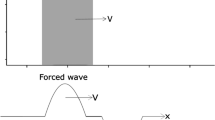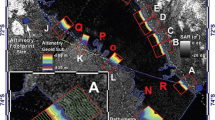Abstract
The tsunami event generated by the great Sumatra–Andaman earthquake on 26 December 2004 was simulated with the recently developed model TsunAWI. The model is based on the finite element method, which allows for a very flexible discretization of the model domain. This is demonstrated by a triangulation of the whole Indian Ocean with a resolution of about 14 km in the deep ocean but a considerably higher resolution of about 500 m in the coastal area. A special focus is put on the Banda Aceh region in the Northern tip of Sumatra. This area was heavily hit by the tsunami and the highest resolution in this area is about 40 m in order to include inundation processes in the model simulation. We compare model results to tide gauge data from all around the Indian Ocean, to satellite altimetry, and field measurements of flow depth in selected locations of the Aceh region. Furthermore, we compare the model results of TsunAWI to the results of a nested grid model (TUNAMI-N3) with the same initial conditions and identical bathymetry and topography in the Aceh region. It turns out that TsunAWI gives accurate estimates of arrival times in distant locations and in the same mesh gives good inundation results when compared to field measurements and nested grid results.
Similar content being viewed by others
References
Ammon JC, Ji C, Thio H, Robinson D, Ni S, Hjorleifsdottir V, Lay T, Das S, Helmberger D, Ichinose G, Polet J, Wald D (2005) Rupture process of the 2004 Sumatra–Andaman earthquake. Science 308:1133–1139
Arcement Jr GJ, Schneider VR (1984) Guide for selecting manning’s roughness coefficients for natural channels and flood plains. Technical report, US Department of Transportation. Federal Highways Administration Reports no. FHWA-TS-84-204, 62 p
Banerjee P, Pollitz FF, Nagarajan B, Bürgmann R (2007) Coseismic slip distributions of the 26 December 2004 Sumatra-Andaman and 28 March 2005 Nias earthquakes from GPS static offsets. Bull Seismol Soc Am 97(1A):S86–S102
Behrens J (2008) TsunAWI—unstructured mesh finite element model for the computation of tsunami scenarios with inundation. In: Habip M (ed) Proceedings of NAFEMS seminar: simulation of complex flows (CFD)—applications and trends, number ISBN 978-1-874376-33-0. NAFEMS Contact DACH & Nordic Countries, Bernau, pp 6–1 ff
Behrens J, Androsov A, Braune S, Danilov S, Harig S, Schröter J, Sein DV, Sidorenko D, Startseva O, Taguchi E (2007) TsunAWI technical documentation part I: mathematical, numerical and implementation concepts. Tsunami Project Documentation No. 004. Alfred-Wegener-Institut, Bremerhaven
Borrero JC, Synolakis CE, Fritz H (2006) Northwest Sumatra field survey after the December 2004 great Sumatra earthquake and Indian Ocean tsunami. Earthq Spectra 22(S3):S93–S104
Danilov S, Kivman G, Schröter J (2004) A finite element ocean model: principles and evaluation. Ocean Model 6(2):125–150
Frey WH, Field DA (1991) Mesh relaxation: a new technique for improving triangulations. Int J Numer Methods Eng 31:1121–1133
Furumoto AS, Tatehata H, Morioko C (1999) Japanese tsunami warning system. Sci Tsunami Hazards 17:85–105
The General Bathymetric Chart of the Oceans (GEBCO) (2008) Webpage http://www.gebco.net
Grilli ST, Ioualalen M, Asavanant J, Shi F, Kirby JT, Asce M, Watts P (2007) Source constraints and model simulation of the December 2006, 2004, Indian Ocean tsunami. J Waterw Port Coast Ocean Eng 133:414–428
Geist EL, Titov V, Arcas D, Pollitz FF, Bilek SL (2007) Implications of the 26 December 2004 Sumatra–Andaman earthquake on tsunami forecast and assessment models for great subduction-zone earthquakes. Bull Seismol Soc Am 97:S249–S270
Hayashi Y (2008) Extracting the 2004 Indian Ocean tsunami signals from sea surface height data observed by satellite altimetry. J Geophys Res 113, C01001:9
Hanert E, LeRoux DY, Legat V, Deleersnijder E (2005) An efficient eulerian finite element method for the shallow water equations. Ocean Model 10:115–136
Hirata K, Satake K, Tanioka Y, Kuragano T, Hasegawa Y, Hayashi Y, Hamada N (2006) The 2004 Indian Ocean tsunami: tsunami source model from satellite altimetry. Earth Planets Space 58:195–201
Imamura F, Yalciner AC, Ozyurt G (2006) Tsunami modelling manual. April
Jaffe BE, Borrero JC, Prasetya GS, Peters R, McAdoo B, Gelfenbaum G, Morton R, Ruggiero P, Higman B, Dengler L, Eeri M, Hidayat R, Kingsley E, Kongko W, Lukijanto, Moore A, Titov V, Yulianto E (2006) Northwest Sumatra and offshore islands field survey after the December 2004 Indian Ocean tsunami. Earthq Spectra 22(S3):S105–S135
Kongko W (2007) Investigation on tsunami run-up in Dec. 26 2004 Indian ocean earthquake. In: Presentation on the international workshop on recent developments in tsunami modeling, Bremerhaven, 25–27 April 2007
Kongko W, Istiyanto DC, Irwandi I (2006) Tsunami modeling and field observations of December 26 2004 Indian ocean earthquake. Technical report, Coastal Dynamic Research Center, BPPT Indonesia
Kowalik Z, Knight W, Logan T, Whitmore P (2005). Numerical modeling of the global tsunami: Indonesian tsunami of 26 December 2004. Sci Tsunami Hazards 23:40–56
Kowalik Z, Knight W, Logan T, Whitmore P (2007) The tsunami of 26 December, 2004: numerical modeling and energy considerations. Pure Appl Geophys 164:379–393
Le Roux DY, Lin CA (1998) Finite elemens for shallow-water equation ocean models. Mon Weather Rev 126(7):1931–1951
Lynett PJ, Wu T-R, Liu PL-F (2002) Modeling wave runup with depth-integrated equations. Coast Eng 46:89–107
McAdoo BG, Richardson N, Borrero J (2007) Inundation distances and run-up measurements from ASTER, quickbird and SRTM data, aceh coast, Indonesia. Int J Remote Sens 28:2961–2975
NOA (2008) Tsunami event – December 26, 2004 Indonesia (Sumatra). Webpage http://nctr.pmel.noaa.gov/indo_1204.html
Nagarajan B, Suresh I, Sundar D, Sharma R, Lal AK, Neetu S, Shenoi SSC, Shetye SR, Shankar D (2006) The great tsunami of 26 December 2004: a description based on tide-gauge data from the Indian subcontinent and surrounding areas. Earth Planets Space 58:211–215
Okada Y (1985) Surface deformation due to shear and tenside faults in a half space. Bull Seismol Soc Am 75:1135–1154
Park, J, Anderson K, Aster R, Butler R, Lay T, Simpson D (2005) Global seismographic network records the great Sumatra–Andaman earthquake. EOS 86:57, 60–61
Piatanesi A, Tinti S, Bortolucci E (1999) Finite-element simulations of the 28 December 1908 Messina straits (Southern Italy) tsunami. Phys Chem Earth (A) 24:145–150
Rabinovich AB, Thomson RE (2007) The 26 December 2004 Sumatra tsunami: analysis of tide gauge data from the world ocean part 1. Indian ocean and south Africa. Pure Appl Geophys 164:261–308
Shewchuk JR (1996) Triangle: engineering a 2d quality mesh generator and delaunay triangulator. In: Lin MC, Manocha D (eds) Applied computational geometry: towards geometric engineering. Springer, Heidelberg, pp 203–222
Stacey MW, Nowak ZP (1995) A numerical model of the circulation in Knight inlet, British Columbia, Canada. J Phys Oceanogr 25:1037–1062
SRT (2007) Shuttle radar topography mission X-SAR / SRTM. Webpage http://www.dlr.de/srtm/
Tinti S, Gavagni I (1995) A smoothing algorithm to enhance finite-element tsunami modelling: an application to the 5 February 1783 calabrian case, Italy. Nat Hazards 12:161–197
Titov VV, Gonzalez FI (1997) Implementation and testing of the method of splitting tsunami (MOST) model. Technical Report 1927, NOAA Technical Memorandum ERL PMEL-112
Titov V, Rabinovich AB, Mofjeld HO, Thomson RE, Gonzalez FI (2005) The global reach of the December 2004 Sumatra tsunami. Science 309:2045–2048
Tanioka Y, Yudhicara, Kususose T, Kathiroli S, Nishimura Y, Iwasaki S-I, Satake K (2006) Rupture process of the 2004 great Sumatra–Andaman earthquake estimated from tsunami waveforms. Earth Planets Space 58:203–209
Walters RA (2006) Design considerations for a finite element coastal ocean model. Ocean Model 15:90–100
Walters RA, Goff J (2003) Assessing tsunami hazard along the New Zealand coast. Sci Tsunami Hazards 21:137–153
Author information
Authors and Affiliations
Corresponding author
Additional information
Responsible Editor: Eric Deleersnijder
Rights and permissions
About this article
Cite this article
Harig, S., Chaeroni, Pranowo, W.S. et al. Tsunami simulations on several scales. Ocean Dynamics 58, 429–440 (2008). https://doi.org/10.1007/s10236-008-0162-5
Received:
Accepted:
Published:
Issue Date:
DOI: https://doi.org/10.1007/s10236-008-0162-5




